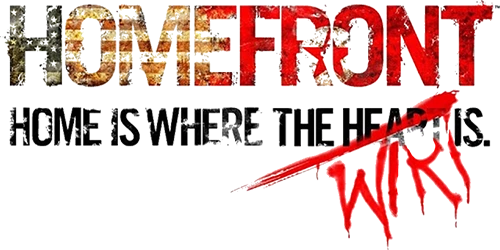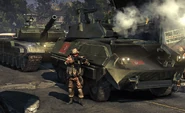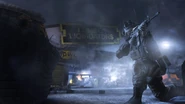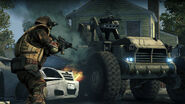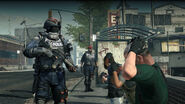Tag: sourceedit |
Tags: Visual edit apiedit |
||
| Line 30: | Line 30: | ||
Eventually the KPA suffered a heavy downfall following the [[Battle of San Francisco]] in the early fall of 2027, by both the United States and American Resistance forces uniting under one banner. The Golden Gate Bridge was secured and San Francisco was than officially liberated turning the tide of the Korean-American War. |
Eventually the KPA suffered a heavy downfall following the [[Battle of San Francisco]] in the early fall of 2027, by both the United States and American Resistance forces uniting under one banner. The Golden Gate Bridge was secured and San Francisco was than officially liberated turning the tide of the Korean-American War. |
||
| − | ==''[[Homefront: The Revolution|Revolution]]'' |
+ | ==''[[Homefront: The Revolution|Revolution]]'' Timeline== |
In 2025, the KPA was deployed to the United States and placing the country under military occupation. Initially, the KPA was to provide supplies and relief to America in order to help it recover from its poverty that had been ongoing from 2008 until leaving the country when the United States settle its foreign debt to North Korea. However, within a few years into the occupation, the KPA forsake its humanitarian mission and gradually become the oppressive rulers of the United States. |
In 2025, the KPA was deployed to the United States and placing the country under military occupation. Initially, the KPA was to provide supplies and relief to America in order to help it recover from its poverty that had been ongoing from 2008 until leaving the country when the United States settle its foreign debt to North Korea. However, within a few years into the occupation, the KPA forsake its humanitarian mission and gradually become the oppressive rulers of the United States. |
||
Revision as of 17:07, 8 January 2017
The Korean People's Army, also known as KPA and Korean Provisional Authority, is the military armed forces of the Greater Korean Republic and is the main antagonistic faction in Homefront and Homefront: The Revolution.
Homefront Timeline
Historical background
Once the standing military force of the Democratic People's Republic of Korea, the army saw action during the Korean War (1950–1953), which ended in an armistice agreement. The Korean People's Army continued to reign as the military force of North Korea, where it faced the forces of South Korea and the United States of America at the Korean Demilitarized Zone for over 50 years following the end of the Korean War. Small engagements between North and South Korea took place within those years, most notably in the first ten years of the 21st century.
Storyline events

Flag of the Korean People's Army.
Following the death of his father Kim Jong-il, Kim Jong-un peacefully reunited the Korean peninsula in 2013 and named it the Greater Korean Republic. As a result, the outdated North Korean military (standing at 4 million strong, including 2.4 million in the reserve) was integrated into the existing South Korean military structures, in which many North Korean officers were discharged and demoted, posted under South Korean officers in order for the Korean government to seek talented generals. Because of this military integration, mandatory military service was eliminated, causing many South Koreans to react positively towards it, as military service in South Korea was compulsory but unpopular.[1]
By 2015, Kim Jong-un, as the increasingly popular President of the GKR, made great strides in modernizing the KPA, replacing and scrapping most of the Soviet-era ordnance and upgrading the Army's training in an accelerated program.[2] The military was also commonly armed with American-made weapons and vehicles, resulting from its integration with the South Korean military, and also utilizing advanced weapons purchased from the Russian and Chinese militaries, including attack helicopters and MBTs. By 2017, the KPA was outfitted with trained special operation teams and was supposedly made as a worldwide peacekeeping force.[3]
In 2018, the modernized KPA first saw combat (technically) in Japan after the Greater Korean Republic went to war with the said nation. KPA forces successfully conquered Japan after having captured 26 Japanese nuclear power plants that are near metropolitan areas and threatened to destroy them following the destruction of the Chugoku nuclear power plant.[4][5] Thereafter, the KPA further served in annexing much of Southeast Asia, including Indonesia, the Philippines, Thailand, Vietnam, Cambodia, Laos, Myanmar, Papua New Guinea, Brunei, East Timor, and Singapore into the GKR; apparently some countries, such as Malaysia, joined voluntarily and for purposes of economic cooperation in an era of global economic decline.
The KPA further participated in several peacekeeping operations in northern Iraq alongside the Iranian Coalition's forces in 2020[6] and successfully intervened in the ethnic violence in Nigeria in 2023. By the latter year, the KPA was lauded by ambassadors and officials worldwide for its actions in Nigeria, along with aid missions to Sri Lanka and hurricane relief efforts in Cuba, greatly improving the GKR's international image.[7] As of 2023, the KPA had grown to 25 million personnel, thanks largely to contributions from GKR member states. Becoming the largest standing army in the world, the KPA includes an Expeditionary Force of more than 5 million troops that was dedicated to "helping countries torn by conflict create a lasting peace."[8]
Furthermore, the KPA's policy allows citizens of the GKR that are joining the military to gain entrance into the GKR's ruling party and secure special privileges, such as unfettered travel among member states and additional fuel rations. Additionally, all family members are guaranteed employment while any one of them is serving in the Republic Military.[8]
By 2024, the GKR launched their own satellites and had set its sights on the financially and militarily weakened United States of America. By 2025, KPA forces began a mass invasion of the United States after an orbital EMP strike that wiped out much of North America's power grid, easily seizing Hawaii, conquering Los Angeles in four days, San Francisco in two, and San Diego in eight hours, securing all U.S. military bases in California and capturing much of their technology, beginning their occupation of the United States. During the next two years, the Korean military had essentially seized all of the United States west of the Mississippi River, and as such commenced with Operation Water Snake in an attempt to divide America, keeping possible assistance from the eastern states at bay while maintaining its strategic hold on the west. Under the Korean Occupation, the KPA enforced a very harsh rule over American citizens and relentlessly made efforts to crush the Resistance, going as far as punishing and even killing American civilians in retaliation to the attacks committed by the Resistance.
Eventually the KPA suffered a heavy downfall following the Battle of San Francisco in the early fall of 2027, by both the United States and American Resistance forces uniting under one banner. The Golden Gate Bridge was secured and San Francisco was than officially liberated turning the tide of the Korean-American War.
Revolution Timeline
In 2025, the KPA was deployed to the United States and placing the country under military occupation. Initially, the KPA was to provide supplies and relief to America in order to help it recover from its poverty that had been ongoing from 2008 until leaving the country when the United States settle its foreign debt to North Korea. However, within a few years into the occupation, the KPA forsake its humanitarian mission and gradually become the oppressive rulers of the United States.
Service Branches
Homefront
Ground Force and Occupational Forces
The Ground Force serves all infantry roles for the Korean People's Army. Although some of their small arms are foreign made, such as the SCAR-L, SCAR-H, and the T3AK, many of their weapons are American-made, such as the M4, M16, M249, Kriss Vector Super V, and the 870 Express. According to a Newspaper Article, the reason for this is stated by Huh Kyung-Young; "Americans make the best weapons, and we want only the best." These firearms were either acquired during the Korean Reunification (as South Korea used some American made firearms due to them formerly being allies), or were most probably taken from U.S. armories during the invasion and subsequent occupation of the United States. They also use drone technology within their forces, including the RQ-10 Parrot, the MQ50 MG Wolverine, the AQ-11 Buzzard, and also autonomous Sentry Towers.
Occupational Police Force
The Occupational Police Force provides all Security and Policing services within all member nations of the Greater Korean Republic, including Japan, Vietnam, Malaysia, and the NKFOA. They mainly carry out their services in towns, cities, labor camps, etc. Nearly all of their small arms conform to those of the Ground Force.
Light Infantry Division
They are in-charge of implementing and maintaining Operation Water Snake. Through Executive Order #4034, the Light Infantry Division redeposits additional Cesium-137, Radioiodine, and Strontium-90 every 17 to 24 months.
Special Operation Force
The original purpose of the Special Operation Force was to launch attacks against South Korean defenses. After the GKR was formed, it attacked the nuclear facilities in Japan forcing it to surrender. Special Operations Force troopers later distinguished themselves in leading the invasion of Hawaii, the first American state to fall in the Korean-American War.
718 Division
The 718 Division is a special forces unit, the KPA's version of the USA's Delta Force. They are first mentioned in Operation Water Snake implementing Operation FanFire, the burning of grasses and forest in the Mississippi River every 3-6 months. They are also used for security in some slave and labor camps. In 2027, they destroyed the Gunnison cell of the American Resistance, and also participated in the Battle of San Francisco. They wear heavy body armor and are primarily equipped with the ACR rifle or SCAR-H LMG.
Foreign collaborators
In addition to Koreans, foreigners were also allowed to join the KPA or sometimes are simply conscripted against their will. They participated in the implementing of Operation Water Snake. Two groups, codenamed Red Eagle (Northern Neo Patriot Front), and Red Bison, deployed the weapon in the Mississippi River. The collaborators have strongholds in Minnesota and Arkansas. After the take over of Japan, the Japan Maritime Self-Defense Force was forced to help the Korean Navy by transporting troops to Los Angeles. Arnie was also the collaborator for the KPA as well as other GKR American collaborators.
The People's Navy provides the KPA with naval support. The KPN operates many cargo freighters to ferry troops and supplies between their home states and across the Pacific to North America. They are first mentioned in Operation Water Snake. They transported Material XYZ, along with the Japan Maritime Self-Defense Force, to Los Angeles. Their major bases in occupied America include Anchorage, Honolulu, Los Angeles, Portland, Seattle, San Diego, and San Francisco. They are again mentioned in Golden Gate. They defended San Francisco Bay against U.S. ships but failed. They also set up a blockade in San Diego bay, to protect the military headquarters located there; however, U.S. Navy destroyers were able to break through this blockade around the time San Francisco was attacked.
People's Air Force
The People's Air Force provides the KPA with aerial support. They have in their inventory a variant of the Su-47 Berkut, a Russian forward swept-wing, supersonic jet fighter; probably also the MiG-29 (a Soviet designed multirole fighter from the former North korean air force), F-15K Slam Eagles (from the former South korean air force), KF-16C/D Fighting Falcon (former South Korean Air Force multirole fighter) and TA/FA-50 Golden Eagle (former South Korean trainer/light attack fighter), the Z-10 Chimera, a Chinese attack helicopter; the UH-60 Blackhawk, an American medium transport helicopter in former South Korean service; the AH-700 Scout, a light armed reconnaissance helicopter; the AH-1 Cobra, an older attack helicopter of American origin an in former South Korean service; the Mi-24 Hind, a combined attack-and-transport helicopter of Soviet origin and in former North Korean service; and various UAVs, including advanced UCAVs. The KPA may also fly other advanced fighters, such as the Russian PAK FA stealth fighter. The People's Air Force also flies confiscated USAF aircrafts including B-1 Lancers, an alternating wing heavy bomber; B-2 Spirits, a wing blended stealth bomber; C-130Js, a propeller cargo aircraft; C-17 Globemasters, a heavy four engine cargo aircraft; F-35 Lightnings, a fifth generation stealth multirole fighter; KC-10 Extenders, a tri-engine tanker; and KC-135 Stratotankers, a legacy tanker. There are KPA air bases in Johnson, Missouri; Minot, North Dakota; and Rosamond, California.
Artillery Guidance Bureau
Also known as the Missile Guidance Bureau, it is the strategic missile force of North Korea. It is equipped with Soviet, Chinese and locally developed missiles. The Artillery Guidance Bureau is connected to the GKR's space agency. It was responsible for launching the new sat-nav network developed by the GKR. It was also responsible for the EMP attack on the United States.
Citizen's Engineering Brigade
In order to "encourage" residents to leave strategic areas, this unit of the KPA breached multiple dams and reservoirs. This caused catastrophic flooding in the surrounding areas and allowed the military to move in. The Engineering Brigade also operates industrial sites, resource mines, transportation hubs, and agricultural complexes. They oversee local American slaves. The only benefit to their operations is the restoration of American infrastructure.
Homefront: The Revolution
Peacekeeper
The Occupational Police Force is replaced as Peacekeeper and are equipped with Magpul PDRs and SAR-21s, with body armor. It appears to offer more mobility and protection than Occupational Police Force and original KPA personnel.
Heavy Peacekeeper
This type of Peacekeeper wearing exo-suit and equipped with heavy machine gun. It takes a lot of fire power to take this type of enemy down. The recommended weapon for this type of peacekeeper are assault rifle, crossbow, machine gun and pipe bomb.
Collaborators
The Collaborators are Americans who are working for the KPA, for their own benefits and their personal wealth. The Collaborators, includes James Crawford and Mayor William Simpson.
Gas Peacekeeper
Peacekeeper personnel that specialized in handling nerve gas for Duster drone in order to be deployed in the Resistance force. Nothing special about this type of Peacekeeper except they carry gas tank that can explode if it gets shot.
Sniper Peacekeeper
The sniper of the KPAs. This type of peacekeeper often need to be killed in order to raise the Heart and Mind meter in the Red Zone. All sniper peackeepers are female.
Arms and Equipment
Homefront
Soldiers of the KPA wear desert camouflaged uniforms and helmets with a beige bulletproof vest and a red handkerchiefs covering their mouths and noses. Their scouts wear red beanies instead of helmets. Whereas the KPA Police were outfits and gear similar to SWAT teams, with the police scouts wearing lighter armor and a red beret instead of a helmet. Snipers on the other hand wear ghillie suits above their uniforms. The KPA has numerous standard issue weapons, but many of them are American made such as the M4 rifle (presumably captured weapons or Chinese copies such as the CQ type A) and few others being made elsewhere, such as the T3AK (from Belgian origin). They have access to numerous drones and vehicles as well, including helicopters, Tanks, armoured personnel carrier, and Humvees.
Weapons
- M9 pistol
- M16 rifle
- M249 machine gun
- PWS Diablo
- ACR rifle
- Super V SMG
- T3AK
- SCAR-L assault rifle
- SCAR-H
- Sentry Tower
Vehicles
- Z-10 Chimera
- AH-700
- UH-60
- T-99
- LAV-25
- Goliath
- RQ-10 Parrot
- AQ-11 Buzzard
- MQ50 MG Wolveine,
- MQ-60 AT Rhino
Homefront: The Revolution
All firearms of the KPA have been equipped with biometric system in order to render its useless in the hand of the resistance.
Vehicles
Gallery
Homefront
Homefront: The Revolution

Sources
- ↑ Unified Korean Military will include many North Korean soldiers
- ↑ New Korean president plans to modernize the Korean military
- ↑ North Korean special forces aim to be "best in the world"
- ↑ Japanese capitulates to Korean occupation
- ↑ Japanese towns, cities evacuated in the aftermath of nuclear power plant destruction
- ↑ Korean Officials provide details of Iraq Operations
- ↑ GKR Peacekeeping mission in Nigeria a success
- ↑ 8.0 8.1 North Korean Military grows
